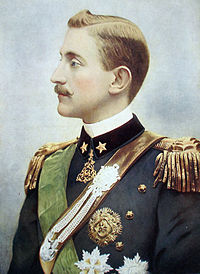Prince Emanuele Filiberto, Duke of Aosta
| Prince Emanuele Filiberto | |||||
|---|---|---|---|---|---|
| Prince of Asturias | |||||
 | |||||
| Duke of Aosta | |||||
| Predecessor | Prince Amedeo, 1st Duke | ||||
| Successor | Prince Amedeo, 3rd Duke | ||||
| Born | 13 January 1869 Genoa | ||||
| Died | 4 July 1931 (aged 62) Turin | ||||
| Burial | |||||
| Spouse | Princess Hélène of Orléans | ||||
| Issue | Amedeo, 3rd Duke of Aosta Aimone, 4th Duke of Aosta | ||||
| |||||
| House | House of Savoy-Aosta | ||||
| Father | Prince Amedeo, Duke of Aosta | ||||
| Mother | Princess Maria Vittoria dal Pozzo, 6th Princess of the Cisterna | ||||
| Military career | |||||
| Nickname(s) | The Undefeated Duke | ||||
| Allegiance | |||||
| Service/ | |||||
| Rank | Marshal of Italy | ||||
| Commands held | Italian Third Army | ||||
| Battles/wars | World War I | ||||
Prince Emanuele Filiberto, 2nd Duke of Aosta (Spanish: Manuel Filiberto; 13 January 1869 – 4 July 1931) was an Italian general and member of the House of Savoy, as the son of Amadeo I, and was also a cousin of Victor Emmanuel III of Italy. Filiberto was also commander of the Italian Third Army during World War I, which earned him the title of the "Undefeated Duke". After the war he became a Marshal of Italy.
Biography
He was born in Genoa the eldest son of Prince Amadeo of Savoy, Duke of Aosta and his first wife Donna Maria Vittoria dal Pozzo della Cisterna. In 1870 his father was elected to occupy the Spanish Throne. Amadeus resigned and returned to Italy in 1873 after three years on the throne. In 1890 his son succeeded to the title of Duke of Aosta.
He began his career in the Italian Army at Naples, in 1905, as commander. During the First World War the Duke of Aosta commanded the Italian Third Army, which gained the nickname of Armata invitta ("undefeated army"). Following the war he was promoted to the rank of Marshal of Italy by Benito Mussolini in 1926.
Prince Emanuele Filiberto died in 1931 at Turin; accordingly to his will, he was buried in the military cemetery of Redipuglia, together with thousands of soldiers of the Third Army.
Named after him were the Duke of Aosta Bridge in Rome, built in 1942, and another on the Piave at Jesolo, inaugurated in 1927; a street in Rome; a cruiser of the Regia Marina was named after him, which was given to Soviet Union after World War II.
Family and children
He was married to Princess Hélène of Orléans (1871–1951). She was a daughter of Prince Philippe of Orléans and the Infanta Maria Isabel of Spain.
They had two sons:
- Amedeo, 3rd Duke of Aosta (21 October 1898 – 3 March 1942); married Princess Anne of Orléans.
- Aimone, 4th Duke of Aosta, who briefly reigned as King Tomislav II of Croatia (9 March 1900 – 29 January 1948); married Princess Irene of Greece and Denmark.
Honours and awards
Italian decorations
 Supreme Order of the Most Holy Annunciation, Knight[1]
Supreme Order of the Most Holy Annunciation, Knight[1] Military Order of Savoy, Grand Cross, 28 December 1916[2]
Military Order of Savoy, Grand Cross, 28 December 1916[2] Gold Medal of Military Valour, 24 June 1937[2]
Gold Medal of Military Valour, 24 June 1937[2]
Foreign decorations
 Royal Hungarian Order of St. Stephen, Grand Cross, 1895 (Austria-Hungary)[3]
Royal Hungarian Order of St. Stephen, Grand Cross, 1895 (Austria-Hungary)[3] Order of the Golden Fleece, Knight, 1899 (Austria-Hungary)[1][4]
Order of the Golden Fleece, Knight, 1899 (Austria-Hungary)[1][4] Order of the Black Eagle, Knight (German Empire)[1]
Order of the Black Eagle, Knight (German Empire)[1] Order of the Rue Crown, Knight (Kingdom of Saxony)[1]
Order of the Rue Crown, Knight (Kingdom of Saxony)[1] Order of the Royal House of Chakri, Knight, 1 June 1897 (Siam)[5]
Order of the Royal House of Chakri, Knight, 1 June 1897 (Siam)[5] Royal Order of the Seraphim, Knight, 18 September 1897 (Sweden-Norway)[1][6]
Royal Order of the Seraphim, Knight, 18 September 1897 (Sweden-Norway)[1][6] Order of the Garter, Knight, 15 July 1902 (United Kingdom)[1][7]
Order of the Garter, Knight, 15 July 1902 (United Kingdom)[1][7]
Ancestry
| Ancestors of Prince Emanuele Filiberto, Duke of Aosta | |||||||||||||||||||||||||||||||||||||||||||||||||||||||||||||||||||||||||||||||||||||||||||||||||||||||||||||||||||||||||||||||||||||||||||||||||||||||||||||||||||||||||||||||||||||||||||||||||||||||||||||||||||||||||||||||||||||||||||||||||||||||||||||||||||||||||||||||||||||||||
|---|---|---|---|---|---|---|---|---|---|---|---|---|---|---|---|---|---|---|---|---|---|---|---|---|---|---|---|---|---|---|---|---|---|---|---|---|---|---|---|---|---|---|---|---|---|---|---|---|---|---|---|---|---|---|---|---|---|---|---|---|---|---|---|---|---|---|---|---|---|---|---|---|---|---|---|---|---|---|---|---|---|---|---|---|---|---|---|---|---|---|---|---|---|---|---|---|---|---|---|---|---|---|---|---|---|---|---|---|---|---|---|---|---|---|---|---|---|---|---|---|---|---|---|---|---|---|---|---|---|---|---|---|---|---|---|---|---|---|---|---|---|---|---|---|---|---|---|---|---|---|---|---|---|---|---|---|---|---|---|---|---|---|---|---|---|---|---|---|---|---|---|---|---|---|---|---|---|---|---|---|---|---|---|---|---|---|---|---|---|---|---|---|---|---|---|---|---|---|---|---|---|---|---|---|---|---|---|---|---|---|---|---|---|---|---|---|---|---|---|---|---|---|---|---|---|---|---|---|---|---|---|---|---|---|---|---|---|---|---|---|---|---|---|---|---|---|---|---|---|---|---|---|---|---|---|---|---|---|---|---|---|---|---|---|---|---|---|---|---|---|---|---|---|---|---|---|---|---|---|---|---|
| |||||||||||||||||||||||||||||||||||||||||||||||||||||||||||||||||||||||||||||||||||||||||||||||||||||||||||||||||||||||||||||||||||||||||||||||||||||||||||||||||||||||||||||||||||||||||||||||||||||||||||||||||||||||||||||||||||||||||||||||||||||||||||||||||||||||||||||||||||||||||
References
- ^ a b c d e f Justus Perthes, Almanach de Gotha (1913) pages 49
- ^ a b "Di Savoia Emanuele Filiberto Duca di Aosta" (in Italian), Il sito ufficiale della Presidenza della Repubblica. Retrieved 2018-08-05.
- ^ "A Szent István Rend tagjai" Archived 22 December 2010 at the Wayback Machine
- ^ "Toison Autrichienne (Austrian Fleece) – 19th century" (in French), Chevaliers de la Toison D'or. Retrieved 2018-08-09.
- ^ Royal Thai Government Gazette (19 September 1897). "พระราชทานเครื่องราชอิสริยาภรณ์ที่ประเทศยุโรป" (PDF) (in Thai). Retrieved 2019-05-08.
{{cite journal}}: Cite journal requires|journal=(help) - ^ Sveriges statskalender (in Swedish), 1905, p. 441, retrieved 2018-01-06 – via runeberg.org
- ^ "No. 27454". The London Gazette. 15 July 1902. p. 4509.
- Encyclopædia Britannica (1950)
- Hanson, Edward (2017). The Wandering Princess: Princess Helene of France, Duchess of Aosta (1871–1951). Fonthill. ISBN 978-1-78155-592-7.
External links
- 1869 births
- 1931 deaths
- House of Savoy
- Italian princes
- Princes of Savoy
- Dukes of Aosta
- Dukes of Apulia
- Italian nobility
- Princes della Cisterna
- Counts of Italy
- People from Genoa
- Knights of the Garter
- Knights of the Golden Fleece of Austria
- Grand Crosses of the Order of Saint Stephen of Hungary
- Field marshals of Italy
- Italian military personnel
- Italian generals
- Italian military personnel of World War I

